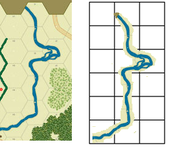BDS Software
Hex vs. Square - Page 1
Wargames need maps. Maps are models of the surface of a planet (either this Earth, or some other world). And models are abstractions; they are approximations of reality; or, perhaps, we might say they are symbolic representations of reality.
To be useful in a wargame (or elsewhere) a map's surface needs to be measurable. In wargames, this is often accomplished by superimposing a grid over the map. A hex grid seems to be the most popular today, but square grids are also useable.
So, I needed to decide whether I generally preferred hex grids or square grids, and why.
Board wargames began with Checkers (~3000 B.C. in Iraq), Go (~2300 B.C. in China), and Chess (~600 A.D. in India?). All three of these games are played on a board which is divided into squares.
So, it's not surprising that the first modern board wargame (Tactics, 1954, Avalon Hill Co.) was also based on a grid of squares.
Writing about American designers of the 1970s and 1980s, van Creveld (p. 153) wrote:
While aiming their work at civilians, they sought to increase realism by providing more rules, not fewer. The decisive change was made when squares were replaced by hexagons, or hexes, as they were commonly called. Dating back to the 1950s, when the navy experimented with them, superficially they were a simple invention. Looking back, one is surprised they had not been introduced much earlier. Hexes had two important advantages. First, they enabled players to move their pieces in six directions rather than four, vastly increasing flexability. Second, when superimposed on a map they enabled frontiers, roads, rivers, coasts, and the like to be drawn much more realistically.
"Being able to move in six directions rather than four" presupposes that, in the squares scenario, diagonal movement is against the rules. Thus, if a game piece is located in a typical square (which we here label as "S" for Starting square) that piece can move North, South, East, or West, at what we will describe as a movement cost of 1 unit per square:
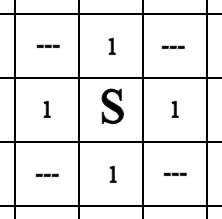
but not in the NE, SE, SW, or NW diagonal directions. This results in very distorted movement and movement costs. In the following diagram, the cost for moving from the Starting square "S" to the Ending square "E" is three squares East, followed by six squares North, or:
Cost = 3 + 6 = 9
as indicated by the path of gray squares:
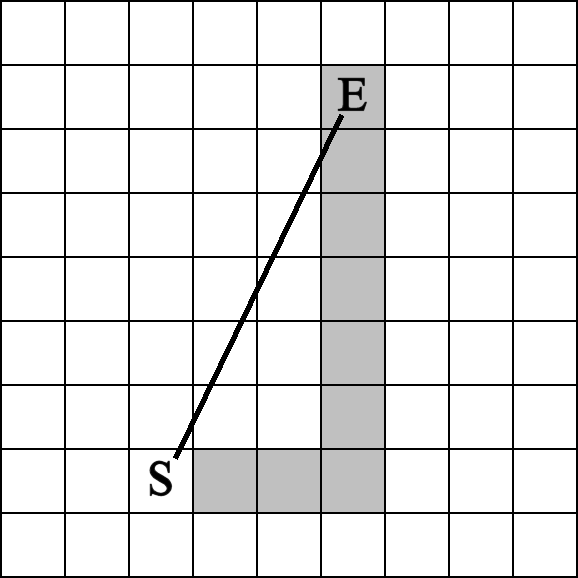
But, this is especially distorted, because the actual cost, as shown by the black line, should more realistically be:
Cost = sqrt( (3)2 + (6)2 ) = sqrt( 45 ) =~ 6.708
When Avalon Hill published Tactics in 1954, and later Tactics II in 1958, the rules allowed diagonal movement as well as NSEW movement, but at a uniform cost of 1 unit per square regardless of direction, like this:
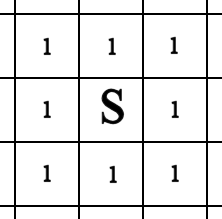
This resulted in a different type of distortion. As seen in the figure below, the NSEW (light blue squares) path has a length and movement cost of:
Cost = 4 + 4 = 8
while the movement cost along the diagonal (black line along the aqua squares) is only 4:
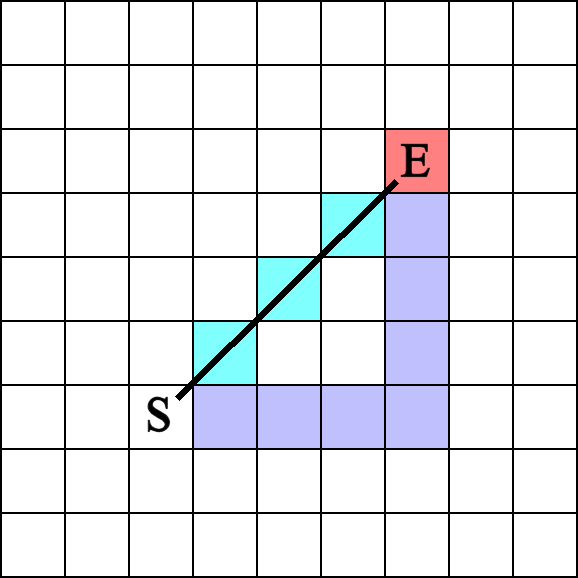
However, the cost of movement along the diagonal would more realistically be:
Cost = sqrt( (4)2 + (4)2 ) = sqrt( 32 ) =~ 5.657
The NSEW path was somewhat objectionable because it over-estimated the distance cost by about 34%. But the diagonal path is significantly MORE objectionable, because it UNDER-estimates the distance cost. The shortest distance between two points is the straight line segment connecting them. We might tolerate a game piece which wanders around and gets to the party late. But, a game piece that tries to use a nonexistant spacewarp to arrive early just won't do.
Conceptually, the simplest solution to this problem would be to allow diagonal movement, but at a cost of sqrt( 2 ) =~ 1.414 units per square in diagonal directions, somewhat like this:
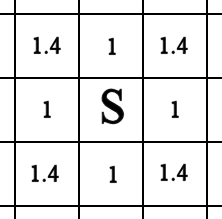
With this adjustment, the cost along the aqua path above would be the correct 4 * sqrt( 2 ) =~ 5.657.
There would still be distortion when paths are not directly along one of the four diagonals, such as in:
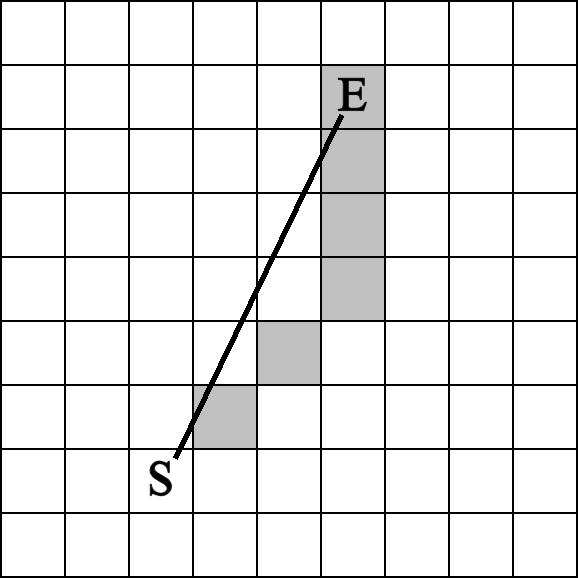
where the actual movement cost along the gray squares path would be 3 * sqrt( 2 ) + 3 =~ 7.243 instead of the more realistic ~6.708 along the black line. This is still a distortion, but in this case, it's only ~8% instead of the ~34% of the NSEW path.
But, while this solution is conceptually simple, it was never a practical solution for actual "physical board" games because counting moves 1, 2, 3, 4 is easy while counting moves 1.414, 2.828, 4.242, 5.656 is not -- (even neglecting the fact that 5.656 is not equal to 5.657).
But, what is difficult for humans is trivial for computers. So, using a square grid and allowing diagonal movement at a cost of sqrt( 2 ) per square could be quite reasonable in the computer equivalent of a board wargame.
Wikipedia Hex Map says:
The hex map has been a favourite for game designers since 1961, when Charles S. Roberts of the Avalon Hill game company published the second edition of Gettysburg with a hex map.
The primary advantage of a hex map over a traditional square grid map is that the distance between the center of each and every pair of adjacent hex cells (or hex) is the same. By comparison, in a square grid map, the distance from the center of each square cell to the center of the four diagonal adjacent cells it shares a corner with is greater than the distance to the center of the four adjacent cells it shares an edge with. This equidistant property of all adjacent hexes is desirable for games in which the measurement of movement is a factor. The other advantage is the fact that neighbouring cells always share edges; there are no two cells with contact at only a point.
One disadvantage of a hex map is that hexes have adjacent cells in only six directions instead of eight, as in a square grid map. Commonly, cells will form continuous straight lines "up" and "down", or "north" and "south", in which case the other four adjacent cells lie "north-west", "north-east", "south-west" and "south-east". As a result, no hex cell has an adjacent hex cell lying directly east or west of it, making movement in a straight line east or west impossible. Instead, paths in these directions, and any other path that does not bisect one of the six cell edges, will "zig-zag"; since no two directions are orthogonal, it is impossible to move forward in one direction without moving backwards slightly in the other.
Returning to van Creveld's remarks, "Being able to move in six directions rather than four" would indicate, for the hexes scenario, equal movement cost of 1 unit per hex whichever of the six directions is chosen, like this:
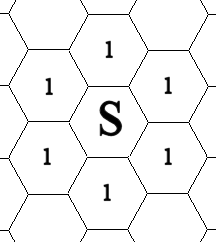
In the hexes scenario, the movement from the same Starting location "S" to the same Ending location "E" would be:
Cost = 3 + 4 = 7
as indicated by the path of gray hexes:
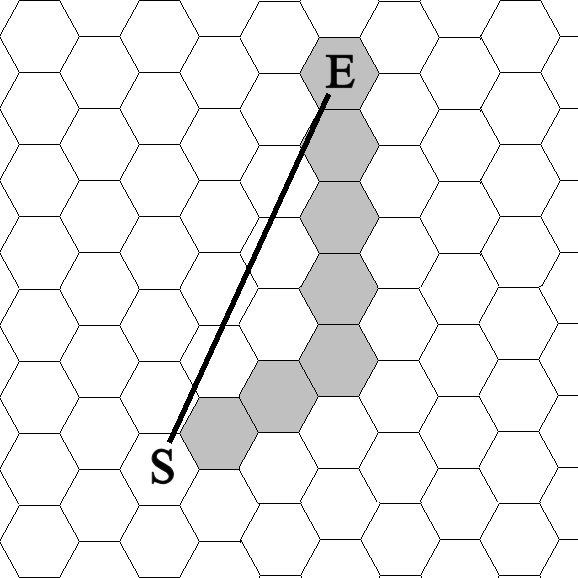
While, again, the black line indicates the more realistic cost of 6.708 - so that the hex path over-estimates the cost by ~4% as compared to the diagonal square path's ~8%.
Technically, however, these percentages are anecdotal, because the distortions will vary depending upon the geometry of the path involved.
Let us assume that all paths are chosen to minimize the movement cost from "S" to "E", for example, the grey path rather than the green path for the squares scenario:
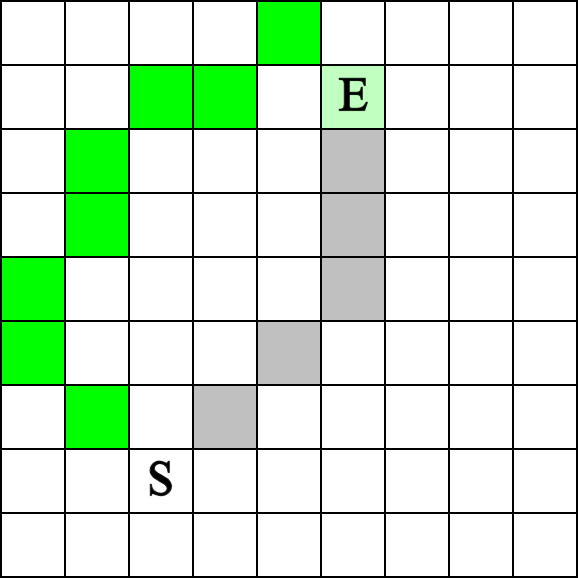
or for the hexes scenario:
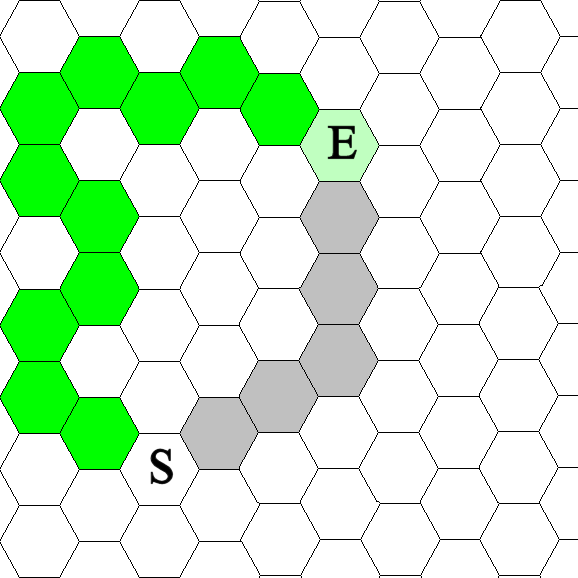
Then, for the squares scenario, the distortion will be zero when the path is either all vertical, all horizontal, or all diagonal:
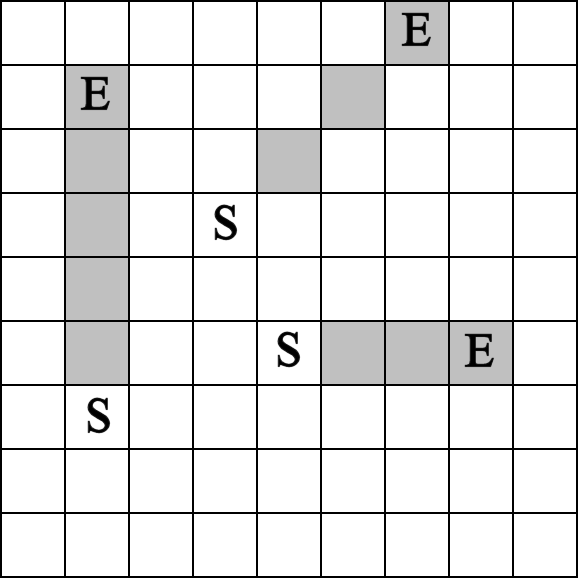
For the hexes scenario, the distortion will be zero when the path is either all vertical or all diagonal:
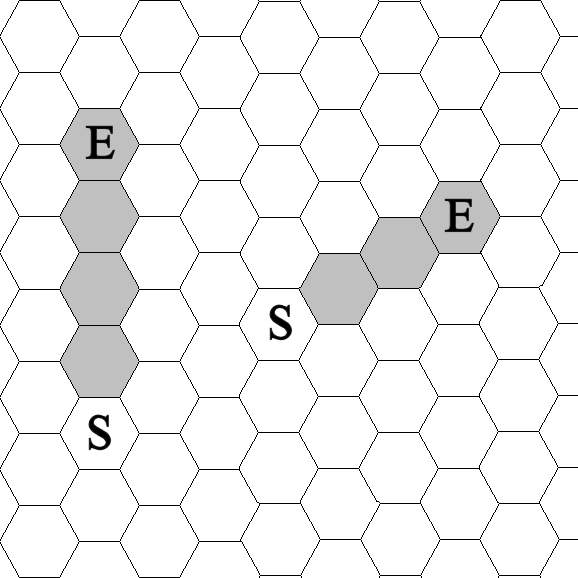
For the squares scenario, the distortion will be maximum when the diagonal portion of the path has the same number of squares as the vertical (or horizontal) portion:
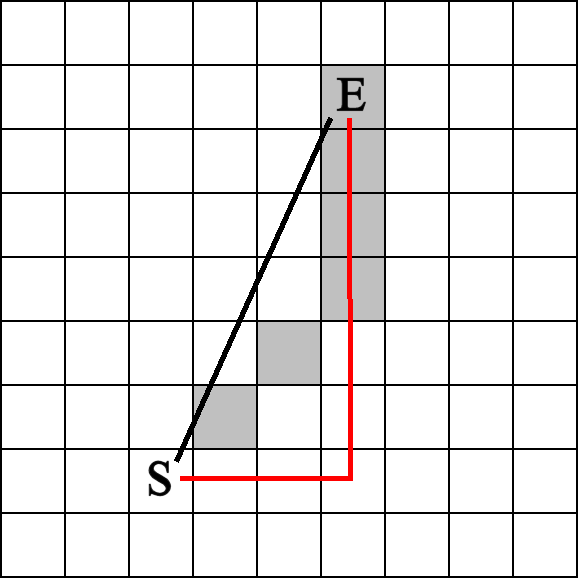
Here, for example, the diagonal portion has three squares and the vertical portion has three squares for a total path cost, as noted before, of 3 * sqrt( 2 ) + 3 =~ 7.243 instead of the more realistic ~6.708 along the black line [ from the red lines = sqrt( (3)2 + (6)2 ) = sqrt( 45 ) ]. The distortion is calculated as:
Distortion = ( ( 7.243 - 6.708 ) / 6.708 ) * 100 =~ 7.976%
Similarly, for the hexes scenario, the distortion will be maximum when the diagonal portion of the path has the same number of hexes as the vertical portion:
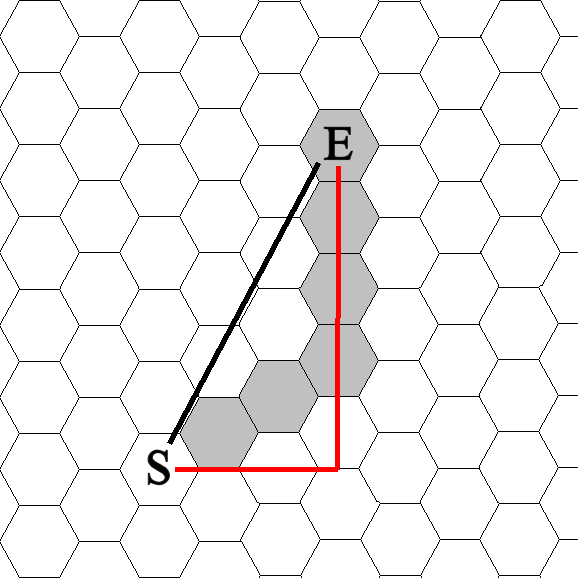
Here, for example, the diagonal portion has three hexes and the vertical portion has three hexes for a total path cost of 6. However, the calculation of the more realistic (i.e. undistorted) black-line path is a little more complicated. From the geometry of hexagons (Wikipedia - Hexagon) we can determine that:
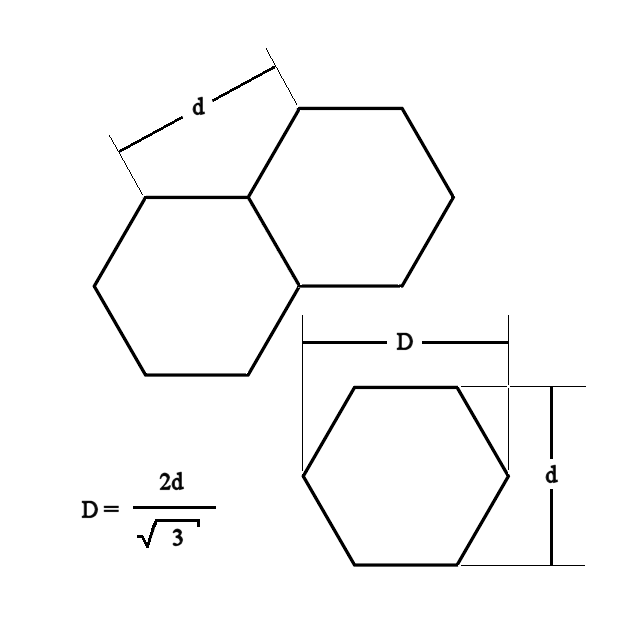
and, since d = 1 unit, then D = 2 / sqrt( 3 ) =~ 1.155.
For the maximum distortion (red-line) hex path above, the East-West distance is therefore:
Distance = ( 1.155 / 2 ) + 1 + 1.155 + 1/2 =~ 3.232
and the North-South distance is 4.500, so that the black-line cost would be:
Cost = sqrt( (3.232)2 + (4.500)2 ) = sqrt( 10.446 + 20.250 ) = sqrt( 30.696 ) =~ 5.540
and the maximum distortion for the hexes scenario would thus be:
Distortion = ( ( 6.000 - 5.540 ) / 5.540 ) * 100 =~ 8.303%
which is greater than the 7.976% for the squares scenario.
Therefore, on the basis of the symbolic geographical representation of reality alone, I would find the squares scenario to be slightly preferrable to the hexes scenario for the computerized equivalents of board wargames.
-----
But, now, let's look at van Creveld's second advantage for hexes over squares, "when [hexes were] superimposed on a map they enabled frontiers, roads, rivers, coasts, and the like to be drawn much more realistically [than with squares]."
To see what van Creveld meant, let's first look at a picture of part of the game board for Tactics II (Amazon - Tactics):
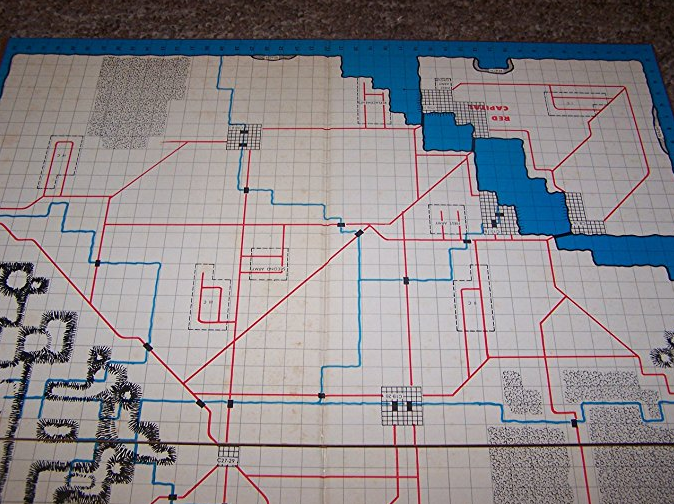
Everything is "semi-squared-off". The cities, mountains, and forests more-or-less occupy full squares, or combinations thereof. Roads run either vertically, horizontally, or diagonally. Waterways strictly follow the edges of squares and change direction only by right angles.
Now, let's take a look at part of a hex map (SPI - Cassino):
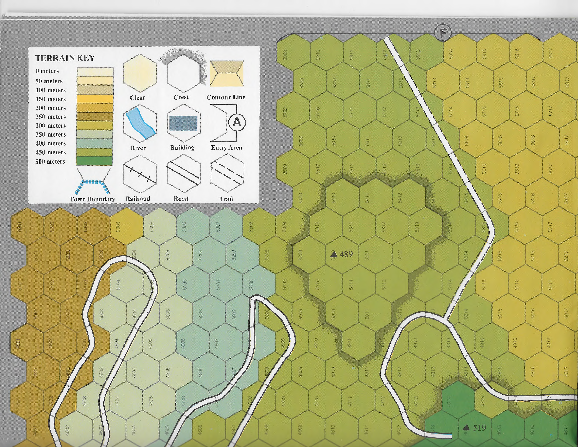
(Click Here for enlarged view)
Terrain features are clearly restricted to individual hexes, or combinations thereof. Roads show some curvature, but are still restricted (as is certainly necessary to avoid imprecision of gameplay) to non-ambiguous entry and exit from each hex. Rivers now run through hexes instead of along their edges, but this would have been workable in Tactics II as well, subject to a bit of a modification of its rules.
All maps are approximations, abstractions, and symbolic representations of reality. They are models which simplify reality in the interests of improving gameplay. With some modifications, I think the squares scenario can be made just as expressive and aesthetic as the hexes scenario.
Certainly, greater realism is possible, if such is desired, with either scenario. On boardgamegeek.com (whatambush) says, regarding one reason others prefer hexes:
"Rivers look terrible on squares and do not look natural"
Most smaller tactical games depict a river as being inside a hex and not along a hex side and you may think that squares make rivers flow unnaturally but just take a look at the image below.
This is the same river taken from a hex grid and transferred to a square grid.
On the basis of these aesthetics alone, I would find that hexes and squares are equally acceptable.
-----
Next Thought: As noted above, Wikipedia Hex Map says: "The other advantage [of hexes] is the fact that neighbouring cells always share edges; there are no two cells with contact at only a point."
The Los Angeles Times reports:
It was long held that Neanderthals and Homo sapiens first lashed stone tips to spears 200,000 to 300,000 years ago. But a study published in Friday's edition of the journal Science contends that a third species, Homo heidelbergensis, developed the technology about 500,000 years ago.
Being a young-Earth advocate, I might question that timeframe. Nonetheless, the existance of weapons which can be launched at an enemy from a distance (and, even throwing rocks qualifies as that), if appropriately handled in the rules, would seem to me to obviate, or at least ameliorate, the necessity for neighboring cells to always share edges.
Based upon this issue alone, I would find that squares and hexes are equally viable for all but exceptionally special circumstances.
Also see my thoughts on Distance Weapons
-----
Conclusion:
Given all of the above, I would conclude that hexes and squares are very close to equal, with squares enjoying a very slight edge on the basis of enjoying less geographical minimum cost path distortion.
This, no doubt, has contributed to the ongoing debate concerning hexes vs. squares which has, to my personal knowledge, continued, without noticeable abatement, from the early 1960's until today -- just check-out almost any game forum on the web.
In general, I've decided to use squares for most of my game designs, mostly because of my desire to develop Spherical Maps and also partially because of the implications of such maps for A* Pathfinding.
Nonetheless, I plan to use hexes for modeling simulations such as the Solar System, other Stellar Systems, and any other systems where the map itself moves, e.g. with its features revolving about a central point.
----------
References:
Amazon - Tactics. https://www.amazon.com/Avalon-Hill-Tactics-Realistic-Military/dp/9990378223 .
Los Angeles Times (2012/11/16). http://articles.latimes.com/2012/nov/16/science/la-sci-hafting-spears-20121116 .
SPI - Cassino (11/1978). "The Battle for Cassino: Assaulting the Gustav Line, 1944" in Strategy & Tactics, Number 71. New York: Simulations Publications, Inc.
van Creveld, Martin (2013). Wargames: From Gladiators to Gigabytes. New York: Cambridge University Press.
whatambush (2012/02/04). https://boardgamegeek.com/thread/760731/defence-squares-please-enter-open-mind .
Wikipedia Hex Map. https://en.wikipedia.org/wiki/Hex_map .
Wikipedia Hexagon. https://en.wikipedia.org/wiki/Hexagon .
M.D.J. 2022/08/17
